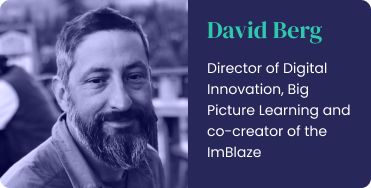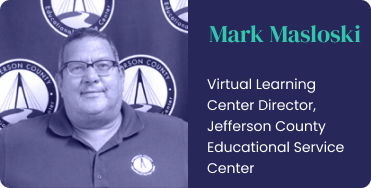
Preparing for our upcoming webinar, Discovering the Secrets of K-12 EdTech Product Adoptions (and if you haven’t signed up yet, here’s the link) I had the chance to interview each of our panelists beforehand. These interviews were recorded, and are available on our Youtube Channel for those of you who would like to gain further insights. For me, the interviews provided preparation for the webinar, helped me shape the questions I will be asking, and gave me a chance to get to know the panelists and their work better.
Three of the interviews are live, one will be released after the webinar. From the discussions with Michael Rubin, Principal of Uxbridge High School in Uxbridge MA, David Berg, Director of Digital Innovation at Big Picture Learning, and Mark Maslowski, Director of the Jefferson County Ohio Virtual Learning Academy, I gleaned the following list of critical keys to success for any EdTech provider looking to gain adoption within the classroom. If you have others, please feel free to share with us via email or on social media — the more we can amplify the voice of our community the better.

1. Solve a problem
When I was speaking with David Berg he brought up an interesting point — many of the EdTech innovators today were successful students in their day, and had positive outcomes. However, based on Gallup Polls conducted and updated over the past 15 years, most students in today’s academic environment do not have the positive outcomes we would hope for, and are not engaged in the process. Thus, the innovators may not have a clear eye on the problems faced by a large majority of students in today’s normalized classroom approach.
The point is, in order to innovate, we need to look hard at solving an existing problem, and often those problems don’t level with what an investor might think is important. Ask yourself, what problem is your product solving, and will it move the needle for teachers, students, administrators or parents? It’s also extremely important to ask (and be critical in answering) if your idea is a nice to have, or a must have.


2. Creates operational efficiencies
The first things that came to mind while speaking with Principal Rubin, which were echoed in a conversation with Dr. Sara Delano Moore, VP of Content and Research at Origo Math, were innovations that help teachers do their jobs. For instance, AI can be useful in creating a second set of assessment items for a lesson, for grading homework and tests, or simply freeing their time so they can spend more time teaching.
A second area of operational efficiency can be centered around empowers students. Tools to help them create their own rubric or learn in unique and productive ways. One example shared was AI that allows students to have a real conversation with a historical figure. This type of innovation is powerful, and allows students to gain a different perspective on the topics at hand.
3. Accessibility matters
No matter if your technology is software, hardware or something else entirely, one thing administrators are looking for is accessibility. This is what can be referred to colloquially as a ‘showstopper’, so if your product or service isn’t accessible, you want to prioritize it before you get too far down the road.

4. Low cost, high yield
These are schools afterall, and budgets will always be challenged (to put it lightly). Capital purchases in schools need to be justified, so keeping cost as reasonable as possible while ensuring its usefulness is important. Principal Rubin brought up his purchase of a Torquebox unit for Bench Drilling. It works for his school because these are the same tools that the students will work with at industry associate locations during internship programs. Secondarily, the students will build transferable skills they can apply on other machines, in different settings. Principal Rubin also noted that the machines they have purchased will be used often for 100 hours a week, 52 weeks a year, so reliability is critical.
His purchasing top three: useful, pragmatic, and reliable.

5. Be courageous
Often it takes courage to buck trends and go against the grain. It’s easier to build something that will gain 1 million users and investors will love than to create a truly transformative solution. Sure, there are times when the world needs a new LMS tool, but there are so many other places that could use innovative ideas and efforts. David Berg spoke about the genesis of the ImBlaze product. One feature of the internship tracking system is administrators can see if students have checked into their internship in real time. As he put it, once that genie is out of the box, it can’t be put back in. Once an administrator knows they have this knowledge they are obligated to use it to improve their programs.

6. Engagement matters
Going back to the Gallup polls I mentioned earlier, the finding consistently show year after year student engagement rates continually dip from 7th grade on. By the time students are in 11th grade, the average engagement is 38%. Putting that another way, 62% of students in 11th and 12th grade are disengaged from learning activities. This is a frightening number, and one that shows the current norms do not function as intended. What we do know is that when students are engaged, when they do take ownership for their learning, outcomes dramatically improve. This is an area that our panelist universally agreed with, and an area that can have the most impact on our education system.
Here’s an article from Forbes that talks about the importance of engagement.

7. Think Different
It was a pleasure talking to Mark Maslowski from the Jefferson County Virtual Learning Academy because you can see the impact that can be made when people think differently about teaching and learning. Mark has over 10,000 students leveraging his team’s services, from multiple states and districts. They have chosen to think differently about education, and it is paying off for so many students that have difficulty adapting to the traditional models for various reasons. Similarly, David Berg and the folks at Big Picture Learning are bravely facing the challenges of the traditional school model and fearlessly turning it on its head. Principal Rubin falls into a similar category, creating pathways where once stood electively he has transformed Uxbridge into a national innovative school model.
Like Steve Jobs and Apple said in their 1997 campaign, Think Different encourages us to see that “life can be much broader once you discover one simple fact, and that is — everything around you that you call life, was made up by people that were no smarter than you. And you can change it, you can influence it, you can build your own things that other people can use.”
